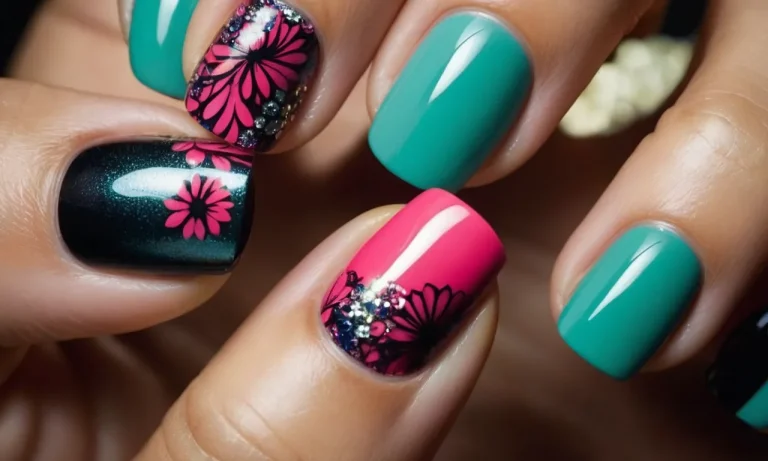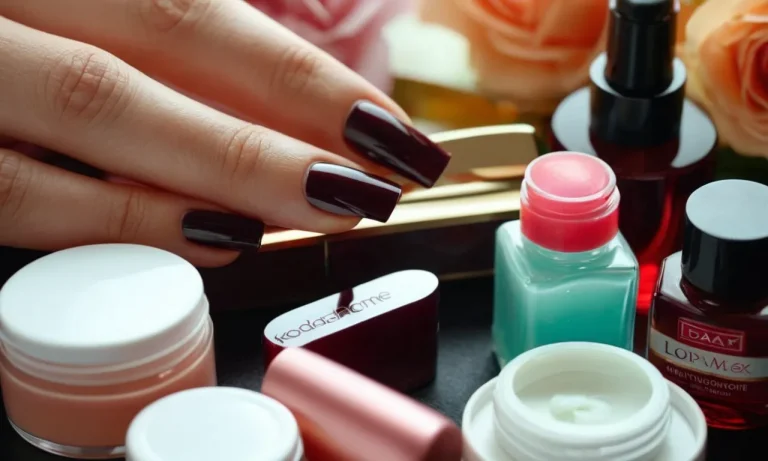Why Does My Pinky Toe Nail Fall Off?
Having a nail randomly fall off your pinky toe can be alarming. But don’t worry, there’s usually a reasonable explanation for this occurrence.
If you’re short on time, here’s a quick answer to your question: Recurring pinky toe nail loss is often caused by injuries, fungal infections, or improper nail care that puts too much pressure on the nail bed.
In this comprehensive guide, we’ll explore all the possible reasons your pinky toe nail falls off. We’ll also provide tips to prevent future nail loss and promote healthy nail growth.
Common Causes of Pinky Toe Nail Loss
Fungal Infections
Fungal infections, known medically as onychomycosis, are a very common cause of pinky toe nail problems. Fungi can infect the nail bed and cause the nail to become discolored, thickened, brittle, or distorted. If left untreated, the infection can eventually destroy the nail and cause it to fall off.
Some things that increase the risk of fungal nail infections include:
- Wearing tight-fitting shoes that don’t allow proper airflow
- Sweating heavily in shoes
- Walking barefoot in public areas like pools or locker rooms
- Having a minor injury to the nail that allows fungi to enter
- Having a suppressed immune system
Fungal infections account for over 50% of nail disorders, according to the American Osteopathic College of Dermatology. They recommend seeing a doctor at the first signs of infection to get proper treatment and prevent spreading.
Repeated Trauma and Injury
Injuries and repetitive trauma are another major cause of nail problems. Even minor impacts or pressure on the toes over time can damage the nail bed and cause the nail to fall off.
Some common causes of trauma-related nail loss include:
- Ill-fitting shoes rubbing repeatedly against the toe
- Dropping heavy objects on the toe
- Stubbing the toe frequently
- Participating in high-impact sports like running or basketball
- Having a job that requires being on your feet all day
One study found that up to 33% of marathon or ultramarathon runners experience toe nail loss due to the constant pounding. Wearing properly fitted shoes and trimming nails straight across can help reduce injury risk (Souza et al, 2009).
Improperly Sized or Poor Quality Footwear
Another preventable cause of pinky toe nail problems is wearing shoes that don’t properly fit. Shoes that are too tight can cause pressure and friction against the toes over time.
Ill-fitting shoes are especially problematic if you have other foot issues like bunions or hammertoes that cause the pinky toe to rub against the shoe. Wide toe box shoes are recommended for those with wider feet or foot abnormalities.
Beyond fit, the quality and materials of the shoes also matter. Breathable leather or mesh shoes can help prevent fungal infections and blisters caused by sweat and moisture buildup. Non-breathable materials like rubber and plastic can worsen existing problems.
Nail or Toenail Bed Disorders
There are also some genetic conditions and chronic nail bed disorders associated with lost or deformed toenails:
- Pincer nails – nails severely curved downward pinching the nail bed
- Ingrown nails – nails growing into the surrounding skin
- Psoriasis – chronic autoimmune condition that can affect nails
These conditions often require special treatment from a podiatrist. Custom orthotics, surgery, or oral medications may be needed alongside keeping the nails properly trimmed.
Other Contributing Factors
Diabetes and Poor Circulation
Diabetes is one of the most common causes of poor circulation in the feet and toes. Over time, high blood sugar levels can damage blood vessels and nerves, restricting blood flow. This makes the feet more prone to injuries and infections.
People with diabetes are at a higher risk of developing ingrown toenails that can become infected and lead to nail loss. Maintaining good blood sugar control is essential to prevent circulation problems that can threaten the toenails.
Peripheral arterial disease, often a complication of diabetes, can also impair circulation to the feet and toes. Plaque accumulation in the leg arteries obstructs oxygen-rich blood from reaching the extremities. Smoking and high cholesterol are risk factors.
Circulation issues make it difficult for wounds and infections to heal properly. Getting vascular testing done can help diagnose any circulatory problems affecting the toes.
Aging
As we age, our nails tend to become thicker and more brittle. Older adults often experience fungal nail infections that can cause the nail to detach from the nail bed. Ingrown toenails are also more common with advanced age as the toenails become misshapen and the surrounding skin loses elasticity.
The aging process slows wound healing, making it harder to treat nail issues.
Nail changes can also result from certain medications commonly used in older adults. Blood thinners, heart drugs, and cancer treatments can all negatively impact nail growth. Always inform your doctor about any nail abnormalities, as they may be a side effect of prescription drugs.
Chemical Exposure
Repeated exposure to certain chemicals may increase the risk of losing a toenail. Prolonged contact with petroleum-based products like motor oils and cleaning solvents can cause nail detachment. Using acidic household cleaners like bleach without protective gear can also irritate the nail beds.
Salon workers who handle nail polish removers and acrylic compounds deal with lots of harsh chemicals that damage nails over time.
Wearing protective gloves and avoiding the overuse of caustic products can help prevent chemical-induced nail loss. Proper ventilation when working with toxic materials is also important. See a doctor if nail changes occur after using industrial-grade chemicals to avoid further damage.
When to See a Doctor
Losing a toenail can be painful and concerning. In most cases, a lost toenail will grow back on its own within 12-18 months. However, there are some instances when you should see a podiatrist or doctor:
- The nail falls off due to trauma or injury. See a doctor to assess the injury and treat any underlying issues.
- The nail bed where the nail fell off looks red, swollen or infected. This could indicate a bacterial or fungal infection that needs medical treatment.
- You have diabetes and lose a toenail. People with diabetes are prone to foot problems and should have any toenail or foot issues examined.
- The nail falls off repeatedly or fails to grow back. Your doctor can check for underlying causes like poor circulation, nail bed damage or autoimmune diseases.
- You have pain, throbbing or discharge where the nail fell out. This suggests infection or inflammation requiring medical care.
- You are taking certain medications like chemotherapy drugs that can cause nails to fall off. Tell your doctor as this may require adjusting dosages or treatments.
Seeing a podiatrist promptly when you lose a toenail unexpectedly can help diagnose and treat any underlying problems. Early intervention may also help prevent future nail loss or deformities.
Tests a podiatrist might do include checking circulation in the feet, examining nail beds, testing for fungal infections, and assessing overall foot health. Treatments can range from oral medications to control infection to minor toenail surgery if the nail bed is severely damaged.
Losing a single pinky toenail with no other symptoms is usually not an emergency. But it’s still a good idea to have your doctor check it out within a few days. This is especially important for people with chronic diseases like diabetes.
Catching and treating minor foot problems early is essential to prevent major complications like ulcers and infections leading to amputation.
Prevention Tips
Practice Proper Foot Hygiene
Keeping your feet clean and dry can help prevent toenail problems. Here are some tips:
- Wash your feet daily with mild soap and water. Rinse and dry thoroughly, especially between the toes.
- Apply powder to help absorb moisture and prevent fungal infections.
- Avoid excessive moisture from sweaty shoes or socks that can soften nails.
- Disinfect pedicure tools and avoid cutting cuticles, which protects against infection.
Wear Well-Fitted Shoes
Shoes that are too tight or rub against your toes can put pressure on nails, eventually causing them to fall off. Follow these shoe guidelines:
- Select shoes with a wide toe box and smooth interior lining.
- Properly measure your feet when buying new shoes.
- Avoid narrow high heels or pointed toes that cram toes.
- Don’t wear the same shoes every day to allow them to air out.
Trim Nails Properly
Cutting your nails incorrectly can damage the nail bed and lead to losing nails. Use these proper nail trimming techniques:
- Trim nails straight across to avoid ingrown edges that dig into skin.
- Smooth rough edges with an emery board or nail file.
- Don’t cut cuticles, which protect and seal the nail base.
- Trim toenails after showering when softened and prevent cracking.
Moisturize Nails and Cuticles
Keep nails and surrounding skin supple to avoid brittle, cracking nails that fall off easier. Try these moisturizing tips:
- Apply a hydrating nail cream daily with moisturizing oils like jojoba, vitamin E or shea butter.
- Use a hydrating cuticle oil around the nail bed and gently push back cuticles.
- Avoid harsh nail polish removers as these can dry and damage nails.
- Consider wearing plastic gloves when washing dishes or cleaning to protect nails.
Treatment Options
Medications
If an infection is causing the nail loss, doctors may prescribe oral or topical antibiotics to clear the infection and prevent further nail damage. Commonly prescribed antibiotics include dicloxacillin, cephalexin, clindamycin, and erythromycin.
Topical antifungal medications like terbinafine cream may also be used for fungal infections. Over-the-counter pain medications like acetaminophen or ibuprofen can temporarily relieve discomfort associated with nail loss.
Surgery
In severe cases, the doctor may recommend partial or complete surgical removal of the damaged nail (nail avulsion) to improve symptoms. This is followed by chemical or surgical destruction of the nail matrix to prevent regrowth.
Surgery allows examination of underlying nail tissue to check for cancer. It also reduces risk of future infections. The toenail typically regrows in 12 to 18 months. Toenail surgery is done using local anesthesia and has a high success rate for preventing repeat nail loss.
Laser Therapy
Latest advancements have seen laser therapy emerge as an alternative to nail avulsion surgery. It involves using focused laser energy to destroy the unhealthy part of the nail and matrix. The heat from the laser beam can successfully eradicate infections as well.
The non-invasive nature of the procedure means no anesthesia is required. Patients experience less pain or discomfort compared to conventional surgery. Laser therapy also has better cosmetic results and allows faster healing.
Conclusion
Losing a pinky toe nail can be alarming but is rarely a cause for serious concern. In most cases, it’s caused by minor injuries or fungal infections and can be prevented with proper foot care.
See your doctor if the nail loss is persistent, spreading to other nails, or accompanied by other symptoms like pain or discoloration. With treatment, your nail will likely grow back healthy and strong again.
Following the prevention tips can help you have happy and healthy pinky toe nails for life!







